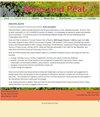厄瓜多尔安第斯山脉放牧和未受干扰的山地泥炭地的二氧化碳和甲烷通量
IF 1.5
4区 环境科学与生态学
Q4 ENVIRONMENTAL SCIENCES
引用次数: 19
摘要
泥炭地分布在整个安第斯热带地区。尽管这些生态系统中有大量的碳储量,但缺乏二氧化碳(CO2)和甲烷(CH4)通量数据。此外,放牧在帕拉莫地区很普遍,可能会改变气体流量。因此,我们的目标是在厄瓜多尔山区未受干扰和密集放牧的泥炭地中,使用静态室技术测量CO2和CH4通量。我们发现,与草坪相比,未扰动场地的鹰嘴豆泥具有更高的净生态系统交换(NEE)、初级生产总值(GPP)、生态系统呼吸(ER)和CH4通量。相反,放牧地的微观地形不能预测CO2通量,而植被覆盖率与所有三个指标(NEE、ER和GPP)相关。在植被覆盖率较低的情况下,NEE为正(损失碳)。未扰动场地的CH4排放量较低(8.1 mg CH4 m-2 d-1)。相比之下,放牧地点的CH4排放量要大得多(132.3 mg CH4 m-2 d-1)。这可能是由于牛的践踏和营养投入造成的。总之,这两个泥炭地的二氧化碳和甲烷交换率差异很大,这可能是由于气候和水文的变化,也可能是由于牛的密集放牧。本文章由计算机程序翻译,如有差异,请以英文原文为准。
Carbon dioxide and methane fluxes in grazed and undisturbed mountain peatlands in the Ecuadorian Andes
Peatlands are widespread throughout the tropical Andean paramo. Despite the large carbon stocks in these ecosystems, carbon dioxide (CO2) and methane (CH4) flux data are lacking. In addition, cattle grazing is widespread in the paramo and could alter gas fluxes. Therefore, our objectives were to measure CO2 and CH4 fluxes with the static chamber technique in an undisturbed and in an intensively cattle grazed peatland in the mountains of Ecuador. We found that hummocks in the undisturbed site had higher net ecosystem exchange (NEE), gross primary production (GPP), ecosystem respiration (ER), and CH4 fluxes, compared to lawns. In contrast, microtopography at the grazed site did not predict CO2 fluxes, whereas vegetation cover was correlated for all three metrics (NEE, ER, and GPP). At low vegetation cover, NEE was positive (losing carbon). CH4 emissions in the undisturbed site were low (8.1 mg CH4 m-2 d-1). In contrast, CH4 emissions at the grazed site were much greater (132.3 mg CH4 m-2 d-1). This is probably attributable to trampling and nutrient inputs from cattle. In summary, the two peatlands differed greatly in CO2 and CH4 exchange rates, which could be due to the variation in climate and hydrology, or alternatively to intensive grazing by cattle.
求助全文
通过发布文献求助,成功后即可免费获取论文全文。
去求助
来源期刊

Mires and Peat
ENVIRONMENTAL SCIENCES-
CiteScore
2.30
自引率
16.70%
发文量
0
审稿时长
33 weeks
期刊介绍:
Mires and Peat is a peer-reviewed internet journal focusing specifically on mires, peatlands and peat. As a truly “free-to-users” publication (i.e. NO CHARGES to authors OR readers), it is immediately accessible to readers and potential authors worldwide. It is published jointly by the International Peatland Society (IPS) and the International Mire Conservation Group (IMCG).
Mires and Peat is indexed by Thomson Reuters Web of Science (2017 Impact Factors: 1.326 [two-year] and 1.638 [five-year]), Elsevier Scopus, EBSCO Environment Complete, CABI Abstracts, CSA Proquest (including their Aquatic Science and Fisheries Abstracts ASFA, Ecology, Entomology, Animal Behavior, Aqualine and Pollution databases) and Directory of Open Access Journals (DOAJ). Mires and Peat also participates in the CABI Full Text Repository, and subscribes to the Portico E-journal Preservation Service (LTPA).
Mires and Peat publishes high-quality research papers on all aspects of peatland science, technology and wise use, including:
ecology, hydrology, survey, inventory, classification, functions and values of mires and peatlands;
scientific, economic and human aspects of the management of peatlands for agriculture, forestry, nature conservation, environmental protection, peat extraction, industrial development and other purposes;
biological, physical and chemical characteristics of peat; and
climate change and peatlands.
Short communications and review articles on these and related topics will also be considered; and suggestions for special issues of the Journal based on the proceedings of conferences, seminars, symposia and workshops will be welcomed. The submission of material by authors and from countries whose work would otherwise be inaccessible to the international community is particularly encouraged.
 求助内容:
求助内容: 应助结果提醒方式:
应助结果提醒方式:


